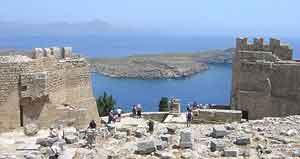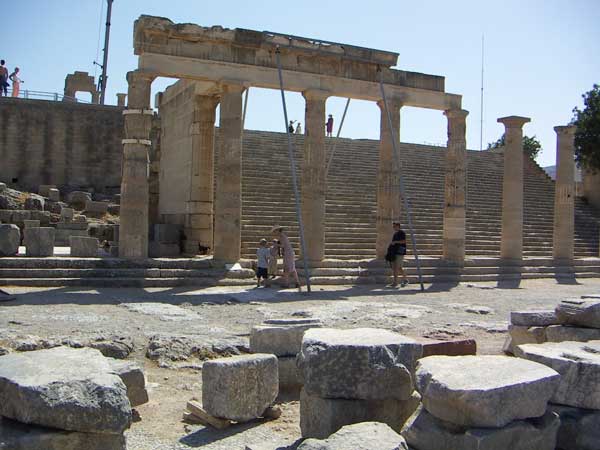.
Lindos (Greek Λινδος) is a town and an archaeological site on the east coast of the island of Rhodes (Rhodhos) in the Dodecanese Islands in south-eastern Greece. It is about 55km south of the town of Rhodes and its fine beaches make it a popular tourist and holiday destination.

Acropolis of Lindos: the restored stoa
Above the modern town rises the acropolis of Lindos, a natural citadel which was fortified successively by the Greeks, the Romans, the Byzantines, the Knights of St John and the Ottomans. This makes the site difficult to excavate and interpret archaeologically. The acropolis offers spectacular views of the surrounding harbours and coastline.
History
Lindos was founded by the Dorian Greeks who arrived in about the 10th century BC. It was one of six Dorian cities in the area known as the Dorian Hexapolis. The eastern location of Rhodes made it a natural meeting place between the Greeks and the Phoenicians, and by the 8th century Lindos was a major trading centre. Its importance declined after the foundation of the city of Rhodes in the late 5th century.
In classical times the acropolis of Lindos was dominated by the massive temple of Athena Lindia, which attained its final form in around 300 BC. In Hellenistic and Roman times the temple precinct grew as more buildings were added. In early mediaeval times these buildings fell into disuse, and in the 14th century they were partly overlaid by a massive fortress built on the acropolis by the Knights of St John to defend the island against the Ottomans.
On the acropolis

View from the acropolis of Lindos

Doric Stoa center (July 2005) (Source)
On the acropolis of Lindos today parts of the following buildings may still be seen:
The Doric Temple of Athena Lindia, dating from about 300 BC, built on the site of an earlier temple. Inside the temple is the table of offerings and the base of the cult statue of Athena.
The Propylaea of the Sanctuary, also dating from the 4th century BC. A monumental staircase leads to a D-shaped stoa and a wall with five door openings.
The Hellenistic stoa with lateral projecting wings, dating from aboput 200 BC. The stoa is 87 metres long and consisted of 42 columns.
The famous relief of a Rhodian trireme (warship) cut into the rock at the foot of the steps leading to the acropolis. On the bow stood a statue of General Hagesander, the work of the sculptor Pythokritos, who also carved the Winged Victory of Samothrace. The relief dates from about 180 BC.
The Hellenistic staircase (2nd century BC) leading to the main archaeological area of the acropolis.
Remains of a Roman Temple, possibly dedicated to the Emperor Diocletian and dating from about 300 AD.
The Acropolis is surrounded by a Hellenistic wall contemporary with the Propylaea and the stairway leading to the entrance to the site. A Roman inscription says that the wall and square towers were repaired at the expense of P Aelius Hagetor, the priest of Athena in the 2nd century AD.
The Castle of the Knights of St John, built some time before 1317 on the foundations of older Byzantine fortifications. The walls and towers follow the natural conformation of the cliff. A pentagonal tower on the south side commanded the harbour, the settlement and the road from the south of the island. There was a large round tower on the east facing the sea and two more, one round and the other on a corner, on the northeast side of the enceinte. Today one of the towers at the southwest corner and one to the west survive.
The Greek Orthodox Church of St John, dating from the 13th or 14th century and built on the ruins of a previous church, which may have been built as early as the 6th century.
Excavations
Excavations were carried out at Lindos in the years 1900 to 1914 by the Carlsberg Institute of Denmark, directed by K F Kinch and Christian Blinkenberg. The acropolis site was excavated down to bedrock and the foundations of all the buildings were uncovered.
During the Italian occupation of the island (1912 to 1945) major "restoration" work was carried out on the Lindos acropolis, of a kind which modern archaeologists do not approve of. The north-east side of the Temple of Athena was restored. The monumental staircase to the propylaea was rebuilt and many of the columns of the Hellenistic stoa were re-erected. Large surfaces were covered with concrete. Bases and inscribed blocks were taken from their locations and placed along the restored walls.
Much of this work was done without taking into account the excavation evidence and without due care for the surviving architectural remains. In recent years Greek and international archaeologists under the supervision of the Greek Ministry of Culture have been working to restore and protect the ancient buildings on the acropolis, but this is made difficult by the increasing volume of tourist traffic.
| Ancient Greece
Science, Technology , Medicine , Warfare, , Biographies , Life , Cities/Places/Maps , Arts , Literature , Philosophy ,Olympics, Mythology , History , Images Medieval Greece / Byzantine Empire Science, Technology, Arts, , Warfare , Literature, Biographies, Icons, History Modern Greece Cities, Islands, Regions, Fauna/Flora ,Biographies , History , Warfare, Science/Technology, Literature, Music , Arts , Film/Actors , Sport , Fashion --- |
Retrieved from "http://en.wikipedia.org/"
All text is available under the terms of the GNU Free Documentation License


